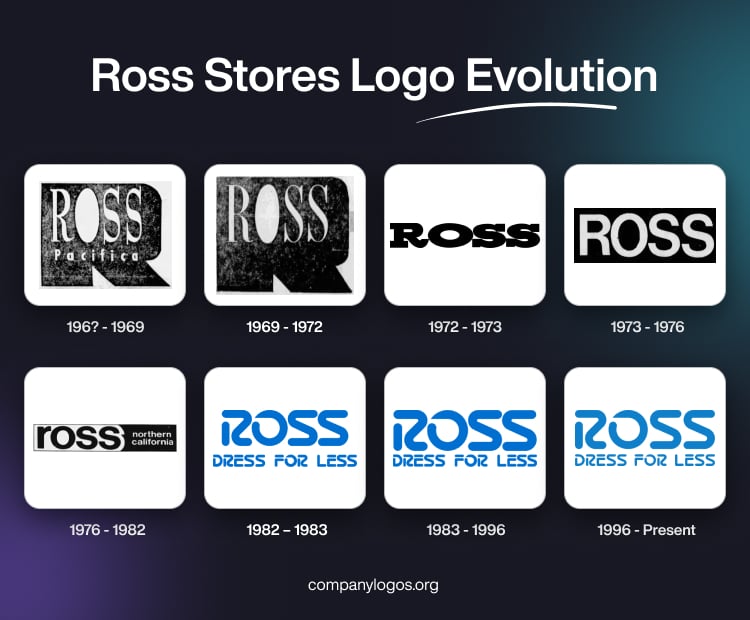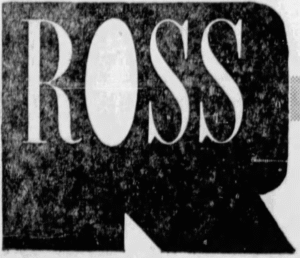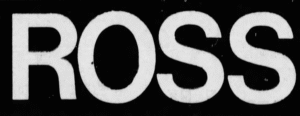
Ross Stores is a prominent American retail chain known for offering a wide range of branded apparel, footwear, accessories, and home décor at discounted prices. Based in Dublin, California, USA, Ross Stores targets budget-conscious shoppers by providing quality merchandise at savings of 20% to 60% off department and speciality store prices.
Founded in 1982, Ross Stores continues to be a major player in the retail landscape, especially with consumers who seek value and affordability in their shopping choices. The visual identity of Ross Stores has undergone a few changes, which are discussed in this article, among other details of the company.
The Genesis of the Ross Stores Logo (1950 – 196?) (Unavailable)
Ross Stores originated in 1950 when Morris Ross opened the first department store in San Bruno, California. There is no archival evidence of the original logo, but it likely featured the brand name using straightforward typography. It would have emphasised the Ross name without any distinctive branding elements, which was common for regional department stores at the time.
(196? – 1969)
The first logo change took place somewhere in the sixties, and it featured the wordmarks “ROSS” and “Pacifica” in white set against a massive letter “R” in black acting as a background. The letter “O” in Ross was a solid white, and the letters had elongated serifs.

(1969 – 1972)
In the 1969 logo variant, the wordmark “Pacifica” was removed, while the rest of the elements were retained.

(1972 – 1973)
In the logo design of 1972, the brand name was written in a bold, geometric, rounded, sans-serif typeface in black against a white background. The individual letters of the wordmark seem to be stretched at their edges.

(1973 – 1976)
The logo design of 1973 was similar to the 1969 one, but without the massive letter “R” acting as the background. It featured the letters “Ross” in white uppercase in a sans-serif typeface against a black rectangular background.

(1976 – 1982)
The 1976 variant featured the words “ross” and “northern california” in a horizontally oriented rectangle that was divided into two parts. The left had the wordmark “ross” in black lowercase against a white background, while the right had the wordmarks “northern california” in white lowercase set against a black background in two levels.

(1982 – 1983)
The logo from this era featured bold, sans-serif lettering to emphasise clarity and affordability. The colour palette shifted toward blue and white, colours that are commonly associated with trust, value, and accessibility in retail. The wordmarks “Ross” and “Dress for less” in blue uppercase had a bold customised typeface. Certain letters in the wordmarks had disjointed ends, which gave them a stylised look.

(1983 – 1996)
As Ross Stores expanded rapidly across California and into new markets following its 1985 IPO, the logo underwent subtle refinements. This was done to enhance recognition and consistency across hundreds of locations. For instance, the logo became more streamlined, with cleaner lines and a more uniform typography. The blue-and-white colour scheme was retained to reinforce the brand’s association with value and reliability.

(1996 – Present)
The current logo features a distinctive, rounded sans-serif typeface with the word “ROSS” in large, bold letters. It is also accompanied by the tagline “Dress for Less” in smaller text below. The logo’s blue colour was made a little light to enhance its appeal in both physical and digital environments. The colour scheme used to design the logo is called “cyan-blue azure.” The contemporary design is minimalist and focuses on legibility and instant brand recognition.

The Elements of the Ross Stores Logo
Font
The wordmark that forms the Ross Stores logo is written using a custom, rounded sans-serif typeface. The letters are bold, clean, and geometric and are designed to maximise legibility and brand recognition.
Colour
The signature colour of the Ross Stores logo is a vibrant shade of blue, which is officially described as “cyan-blue azure”. The colour blue symbolises trust, reliability, and value—qualities central to the Ross brand identity.
The History of Ross Stores
Ross Stores traces its origins to 1950, when Morris “Morrie” Ross opened the first Ross Department Store in San Bruno, California. Ross managed the store personally and handled both buying and bookkeeping duties. In 1958, he sold the business to William Isackson, who expanded the chain to six stores across the San Francisco Bay Area. It included locations in San Bruno, Pacifica, Novato, Vacaville, Redwood City, and Castro Valley.
In 1982, a group of investors led by Stuart Moldaw and which included Mervin Morris (founder of Mervyn’s) acquired the six-store chain. Moldaw and Donald Rowlett, both experienced in off-price retail, shifted Ross’s business model from a traditional department store to an off-price format. They launched the “Ross Dress for Less” concept. This strategy focused on offering branded apparel and home goods at significant discounts, a model that was then rare in California.
By the end of 1983, the chain had grown to 18 stores, which included its first location outside California in Reno, Nevada. In 1984, Ross acquired 15 stores from the Handyman division of Edison Brothers Stores. This accelerated its growth and entry into new markets in Texas and Oklahoma.
Ross Stores went public on August 8, 1985, and traded on Nasdaq under the symbol “ROST”. The public offering provided capital for further expansion, and by the end of 1985, the company operated 107 stores, which was a dramatic increase from just six stores three years earlier. Throughout the late 1980s and 1990s, Ross continued to expand across the United States. It reached 292 stores in 18 states with annual sales of $1.4 billion by 1995.
The 2000s saw further growth, with Ross opening dozens of new stores each year and entering new markets. By 2012, the company operated over 1,000 Ross Dress for Less stores and more than 100 dd’s Discounts locations, a secondary off-price chain. The headquarters of the company moved from Newark, California, to Pleasanton in 2003 and then to Dublin, California, in 2014.
The period between 2010s and 2020s was marked by leadership changes. For instance, Barbara Rentler became CEO in 2014 and was one of the few women to lead a Fortune 500 company at the time. In 2025, James Conroy succeeded Rentler as CEO.
Interesting Facts About Ross Stores
- Ross operates about 1,795 stores across 43 U.S. states, Washington, D.C., Puerto Rico, and Guam. This makes it the largest off-price retailer in the country. Interestingly, despite this vast presence, Ross has no stores in New England or Alaska.
- Ross Stores also owns and operates dd’s Discounts, a separate chain with over 353 locations, which are mostly concentrated in Sun Belt states.
- The first Ross Department Store was opened in 1950 by Morris “Morrie” Ross in San Bruno, California. Ross personally managed the store by working 85 hours a week and handling all buying and bookkeeping himself.
- In 1982, a group of investors including Mervin Morris (founder of Mervyn’s) purchased the six-store chain and transformed it into an off-price retailer. Within three years, the chain grew to 107 stores under the leadership of Stuart Moldaw and Don Rowlett.
- Ross Stores went public on August 8, 1985, with an initial share price of $17.00. It now trades on the Nasdaq under the symbol “ROST” and is a component of both the Nasdaq-100 and S&P 500 indices.
- By the end of 1995, Ross had 292 stores in 18 states and annual sales of $1.4 billion. By 2012, it had grown to 1,091 stores and $9.7 billion in annual sales.
- Unlike many competitors, Ross has chosen not to pursue e-commerce. It instead focused on the in-store experience and the “treasure hunt” appeal of finding bargains in person.
- Barbara Rentler became CEO in 2014, which made her one of the few women to lead a Fortune 500 company at the time.
- In February 2025, James Conroy succeeded Barbara Rentler as CEO. Conroy was previously the CEO of Boot Barn.
- Ross stores are known for their no-frills layout, which helps keep costs down and allows the company to pass savings onto customers.
- Ross is involved in charitable initiatives and community engagement, which are key aspects of its marketing and brand identity.
- The iconic tagline, “Dress for Less”, encapsulates Ross’s core promise of offering high-quality brands at discounted prices.
Finally
The Ross Stores logo has evolved over the years. It changed from a modest, utilitarian mark to a bold, contemporary emblem that reflects the company’s status as a national leader in off-price retail. Each iteration of the logo has shown key moments in the company’s history. The Ross Stores logo serves as a visual symbol of its enduring commitment to value and accessibility for consumers.